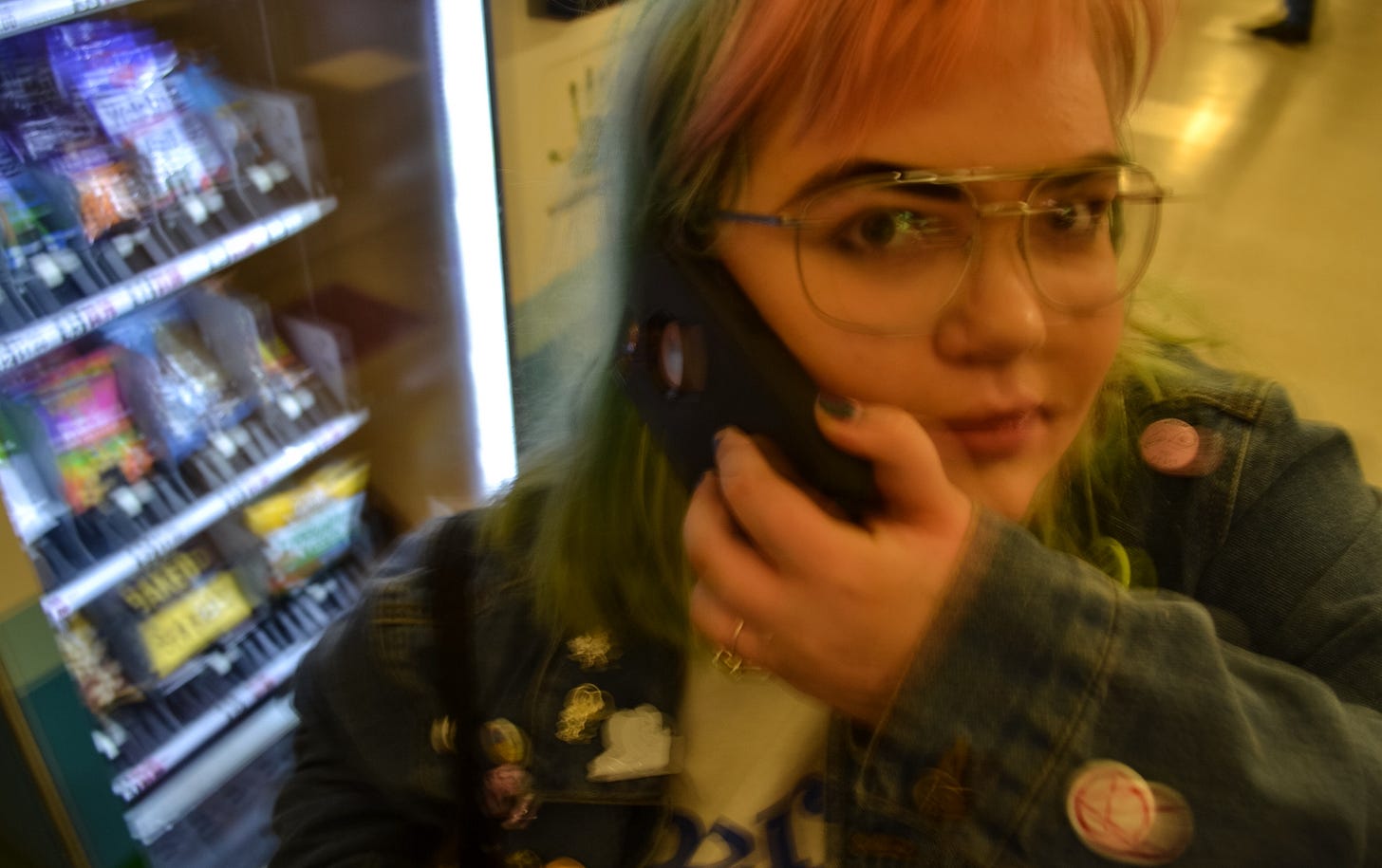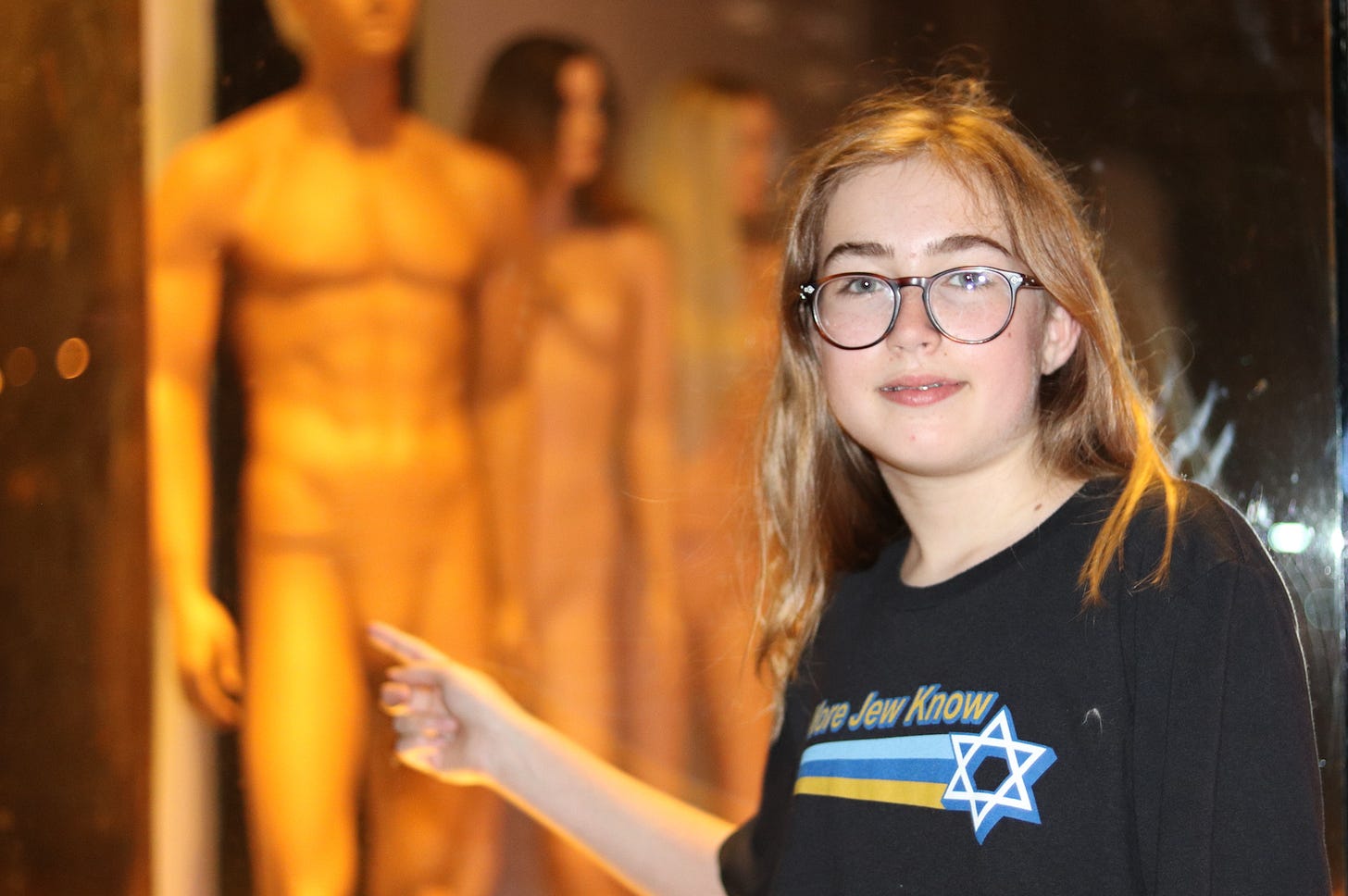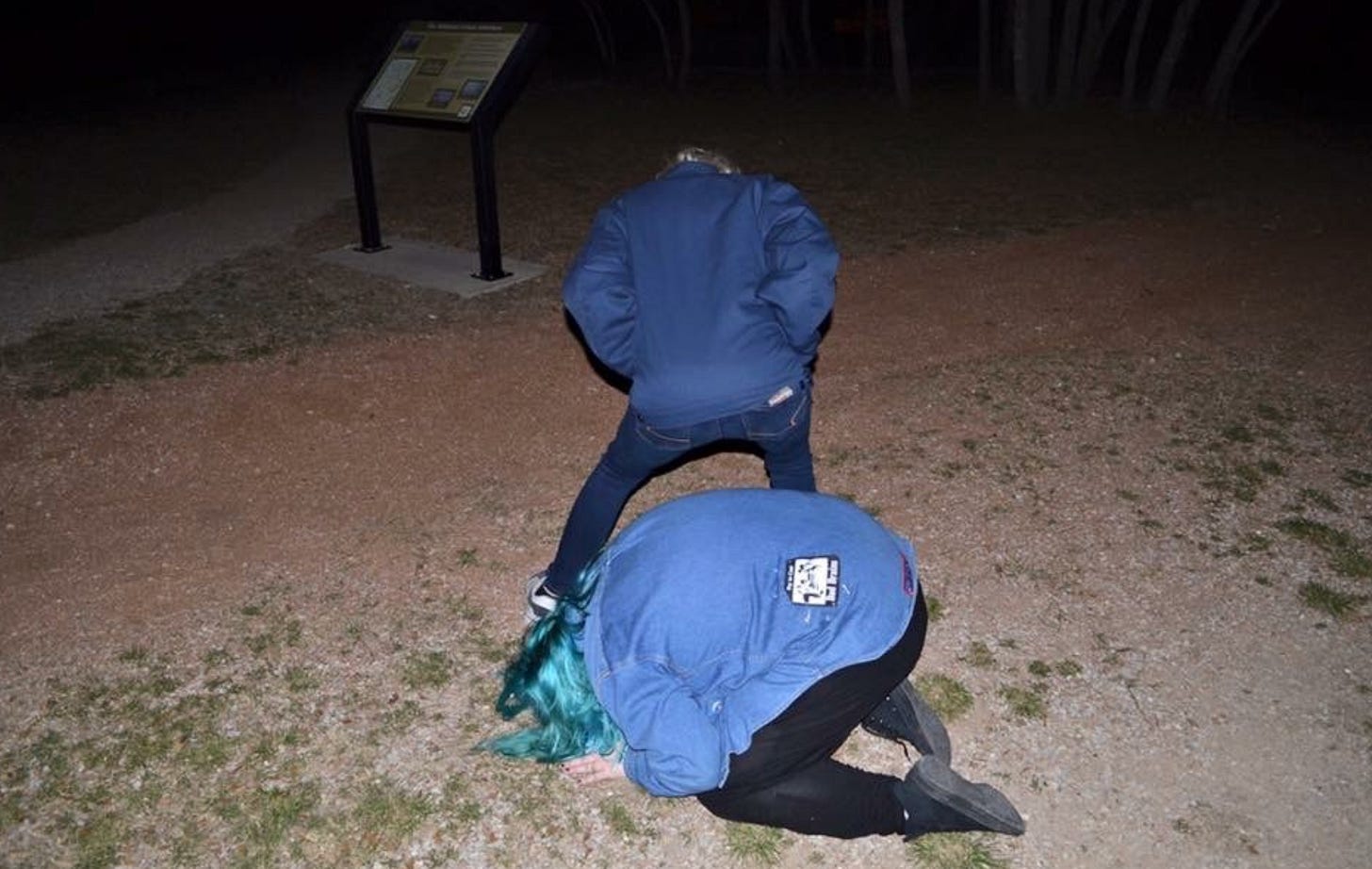Austin, Slacker (1990), Liberal Complacency, and Commodified Strangeness
Transplants, The Californian Ideology, Individualistic Inaction, and Being Weird from the Womb
Richard Linklater, the writer and director of Dazed and Confused (1993) and Boyhood (2014), has long produced love letters to the city of Austin, but his second film, Slacker (1990), best depicts the cultural milieu of the liberal yet stagnant, soon-to-be metropolis. The picture opens with a wayward traveler, played by Linklater, searching for meaning and a sense of direction, but unlike the recent transplants from California and Arizona, Linklater arrives via Greyhound with presumably nothing to his name. He muses about his dreams of nothingness to a silent cab driver, rambles about potential (un)realities, and sets up the film as an exploration of individual experience within a bubble of liberal complacency and strangeness.

Austin has seemingly always homed the odd and unusual, once serving as a hippy hub in the 1960s and 1970s. Our slogan is “Keep Austin Weird,” and yes, Portland stole that from us. Whole Foods started here and was not the Bezos-optimized grocery store we now avoid, but a co-op where grungy white men with dreads sorted alfalfa sprouts on the floor. The salad days of Leslie, the homeless, thong-wearing local celebrity who ran for mayor thrice, are gone and have been replaced by Elon Musk and Joe Rogan, and while these figures are heterodoxical, they are counter to the culture of Austin, and act as present day extensions of The Californian Ideology. Yuppies and tech moguls alike seem to be attracted to the empty streets and close-knit vibe shown in Slacker, but the days of the flower child, Shady Grove, and Hut’s Hamburgers are long departed. The strangeness of the city has faded as it became marketable, as strangeness posits itself as opposite from the norm, and, well, the recent influx of folks are distinctly generic in their affections for Teslas, upscale Tex-Mex, and Cortados.
Perhaps this is offensive to the transplant reader who is sure of her eccentricity; she covers herself in tattoos that require lengthy yet banal explanations about her childhood, is a self proclaimed hair-artist specializing in wolf cuts (and only wolf cuts), and tries to hit the farmers market at least once a month, but she is, nonetheless, not that unusual. I really don’t mean to be so caustic (it’s my nature), and I don’t think the erosion of Austin has been fueled by transient creatives as much as the uber-wealthy with real estate purchasing power. All I’m saying is: the image of strangeness is rather simple to mimic and you are not *that* unique, especially when your interests and turns-of-phrase are an amalgamation of TikTok algorithms. Go to any co-op party on UT’s campus and you will find yourself in a sea of skinny “alternative” kids who dress in Buffalo Exchange selections and vintage-appearing fast fashion garments. Though these folks would want you to believe that they are the most unique beings in Austin, most of them listen to the same noise, hyperpop, or soft indie music and spend 7+ hours a day on social media apps. Most confidently spout their internet-reared political opinions, which typically consist of ACAB sentiments and the technouveau gender ideology, though very few actually rally for what they claim to believe in. Most, like the rest of Americans, just blabber, repost, and play town cryer through a Ketamine daze or perpetual pot high upon their self-righteous soapboxes (aka Instagram stories).
What is perhaps most striking in Slacker are the political parallels between the 1990s and 2023. Aside from the obvious gentrification of UT’s West Campus— where most of the film takes place— and the dwindling supply of strangeness, much of Slacker’s setting and tone are similar to our current dynamics. Issues like climate change are mentioned early on by a man wearing jeans and a Batman tee (a sweaty choice for a sweltering environment):
“They discovered [the greenhouse effect] in the 40s. You can ask yourself what they’ve been doing sitting on their asses for 49 years, huh?...Everybody says ‘Ah, Greenhouse effect. That’s a hundred years from now. Oh, I’ll be long dead and gone…’ Not so my friend…The government’s sitting on the fact that [climate change has] ten to twenty years maximum. It’s getting hotter don’t you think? It’s not even summer yet.”
While he is portrayed as the neighborhood kook, and his half truths are obscured by claims of secret space colonization, his monologue on the melting polar ice caps and ecological chaos hold true. He also mentions how some will “be boosted off this rock before it melts,” evoking thoughts of Elon Musk’s plans to occupy, and, yes, colonize Mars once the wealthy elite deem our planet unlivable due to decades of unmitigated production and consumption.
After a couple leads us into what we can assume to be a co-op, a blonde man in glasses spiels about the minority of Americans who make up the eligible voting population. He mentions the lack of inclusion of the incarcerated (but fails to list felons who are barred from voting even after serving time), noncitizens, young people, and those who are too old to travel to polling booths. Though his soliloquy holds true, much like the conspiracy theorist previously mentioned, the people surrounding him could not be bothered to listen and are absorbed in a Lonestar fueled hand-slap game. We do not know how the other characters view him; he could very well be the pretentious polisci kid who eats up the air, but even if so, the film depicts those surrounding our orators as somewhat apathetic or uncaring. Though someone finally asks where he gets his statistics, it is clear that the speeches of these characters are undervalued and dismissed, and though Gen-Zers at least talk about these issues, very little collective action has been taken by those who are conscious and knowledgeable.
A pair reunites on The Drag (Guadalupe, the main street on UT campus) and begins a debate that seems to represent perspectives of liberalism versus self-reliance. The blonde woman, after giving a homeless man a quarter and a soda, is met with nagging by her male friend who is clearly searching for some sense of philosophical self. She says it's not going to change the homeless man’s life and that's true; donation does not alter the overarching structure as it neglects systemic mental, physical, and fiscal health concerns which lead to homelessness. However, while her charity is not systemically beneficial, it is at least altruistic and serves as a foil to her boy-friend who claims that her actions enable the “base creature” by failing to see the “true potential” in the man on the street. She counters and claims he regurgitates these musings out of the “authoritative sources” he reads rather than critically thinking about his relationship to his environment, and he asserts that she’s indebted to a “slave morality,” cementing himself a Randian moral relativist, reminiscent of the students who blindly ate up The Californian Ideology. The parallel today looks more like Musk and Milton fanboys versus libs who mask as Marxists, but the average, left-of-center college student like the girl in this scene often view voting as inconsequential, and don’t seem to care about much besides what their friends recirculate online. Even then, there is no significant difference between the two populations in terms of action; both are stalemated, and both rather doom-scroll and reaffirm their ideas with like-minded peers.

A bit later, a man coming from a funeral with a cigarette behind his ear is interviewed by film students working on a vague project. Upon being asked if he voted in the last election, he responds, “Hell no, I’ve got less important things to do.” Immediately after, when asked about his employment, he states, “All [work] does is fill the bellies of the pigs who exploit us.” While our seemingly communist comrade continues to rant, spouting that “every single commodity you produce is a piece of your own death,” he has not shown that he cares enough about the state of his world to do anything. He is informed, and has effectively dropped out of capitalistic society by abandoning ambition to work, but has opted to take an individualistic route by avoiding unification over common struggle. This is both pertinent and ironic; most people fall into the same trap of knowing their conditions are not adequate for optimal wellbeing, but somewhere in the process, they dissociate and choose the default option of individualistic inaction even when preaching collectivistic virtues. Regardless if you believe in free will, we continue to take the stream of least resistance when the remedy calls for…resistance.
The film muses on this further with the dialogue of the “Old Anarchist” (UT Professor and Kierkegaardian scholar, Louis Mackey) and the man who just attempted to rob him. Overlooking the Capitol, the anarchist says he wishes to blow up the legislature, taking issue with the “so-called modern-day libertarians with all their goddamn selfish individualism,” and I can’t help but share his sentiments, though I am equally frustrated with those who are closer to my own political alignment. He points out that the legislators he criticizes don’t want to improve their world, and then pontificates, “Charles Whitman, that was a man,” before turning to the UT tower where the infamous “Texas Tower Sniper” slaughtered fourteen1 people in the country’s first school shooting. The film certainly seems to poke fun at the people it centers on, and though the characters point at their fellow Austinites as the crazy weirdos who make the city what it is, they are similarly (slightly) insane and dissociative, coping with the oddities of the American (un)reality as best they can. The professor continues to say, after cursing his dead wife for making him miss the spectacle of ‘66, that he has now given up on “mankind in its entirety.” It seems that all the characters, even those touting an aura of awareness, have turned to nihilism, succumbing to the selfish individualism they critique. Linklater does, however, slyly push back at his own analytic eye later in the menstrual pottery scene through an affirmation card plucked at random: “Withdrawing in disgust is not the same as apathy.”
Slacker hammers down on the sustained trend of liberal complacency while also giving us a taste of the weirdos who once gave this city the flavor we presently crave. My favorite feature shows a scrawny kid (who is the film’s literal poster child) supposedly holding a vial of Madonna’s pap smear juices with one dark pube (there were two, but one was thieved). Before transitioning to the next character study, they attempt to push this 100% authentic specimen to two unassuming students, one of which just got back from “the hospital” (very Austin of her). Minus the obvious scamming, this kind of stunt reminds me of the shenanigans I took part in while at Austin High, the school Dazed and Confused is supposedly based on, home to All Kinds of Hell (the hazing rite of passage for popular kids, rather accurately depicted by Ben Aflack & Joey Lauren Adams) and Mr. Maroo, our ink-blot mascot (again, very Austin).

Austin has always reared and appreciated folks of a certain persuasion, but this marketability of alternativity has formed and incentivized a new breed: the normie who cosplays as the weirdo. Quirkiness may be the culture we sell, but there is a difference between Zoey Deschednel, who profits from her suspiciously commercial quirkiness, and figures like Molly Ivins or Matthew McConneghy who we know are just a little bit *off* (their rockers). The two are difficult to separate, and commodified strangeness depends on original weirdos (who are seldom popular), but a degree of difference can be found between a produced image that is easily mimicked and the internal experience that is wrought with alienation on all fronts.
I have always been somewhat atypical. I had little understanding of “normalcy” growing up, but came to know at a young age that I was not like my peers. Under the dominant identitarian lens, it would be sufficient to claim that because I was a fat, Jewish, queer, and (probably) neurodivergent kid from a broken home, I was targeted by those who viewed me as Other. Though I criticize our collective obsession with identity, it is true that my beingness drew excess attention amongst a Baptist and Aryan student body, albeit I’m also aware that there is something intrinsic to me that is just bizarre and a bit bewildering. I, like the transplants I criticize, was not born in Austin. I think if I had been born in Austin, I would’ve bypassed much of the bullying and abuse that caused us to relocate from Plano, Texas to a more left-leaning area due to fear for my health and safety. But my visual anomalies were merely the crust coating a cakeball of offbeat interests, and the things I was attracted to—things that are objectively strange for a child to like—provided a sense of comfort and belonging that I couldn’t find in people or popular culture.
When I was eight, I sang Eleanor Rigby by The Beatles for the elementary talent show, which should serve as a rough baseline of my peculiarity. The song was not shown to me by a family member, but is a dark tune that I hunted for on my own. I related to the loneliness of the lyrics a bit too much for one ripe out of the womb, though I also favorited Green Day’s American Idiot album, and would use songs like Jesus of Suburbia to fall asleep after allowing my CD player to exhaust its rotation of the early 2000s pop punk melodies. As I aged, I further developed my middle-aged man music taste, and found TOOL, which honestly got me through middle school. I was transfixed by the track Prison Sex, as it related to my day-to-day, though I was unable to articulate what my body was enduring at the time. Something tells me that along with my identity and interests, the bullying was spurred by the smell of suffering. Animals frenzy and relish at the sight of blood; a wounded creature is easier prey, and taking down an Other ensures your own survival and ability to fly under the radar of tyranny.

My music taste was not causation for how I was interpreted, but it certainly added to my general air of nonconformity. In the seventh grade, I attempted to befriend a group of girls who loved One Direction. I claimed that I, a totally normal girl with normal interests, also fangirled for Harry Styles and the rest of the lads. I knew I would be tested, so I studied the 1Ders by scrolling through Tumblr to absorb whatever material a true fan would know. Apparently it was common to know the boys' totally factual penis sizes and home addresses; these were things I did not commit to memory because I felt that though this was normalized, it was too invasive and creepy for little gay me. I soon realized that these girls were not that “normal;” they just avoided in-school torture. They were freaks, too, but freaks with friends. I didn’t survive very long with the group, even though I displayed plenty of depressive symptoms that they collectively romanticized. Like so many isolated kids who attempt to gain the favor of their classmates, I soon became the undemocratically elected punching bag for the painfully heterosexual girls who I had hoped would be my friends. I moved on and found two people who actually attempted to understand me, both of them queer and exiled due to their visual anomalies (non-Aryanness), too.
The main identifier of commodified strangeness is an absence of social alienation. The clout inspired travel in packs, both in real life and online. They have some sense of community—usually with people who have similar interests— but claim they don’t. Back in 2012, when I was in the sixth and seventh grade, the clouty alt kids wore 5 Seconds of Summer (5SOS) shirts with a rebranding of Nirvana’s dead-eyed smiley face. I went up to a girl wearing one of these tees, unaware that it was not a Kurt Cobain print from Hot Topic, and said, “Oh you like Nirvana?! I love Nirvana! I never meet people who like Nirvana!” She responded, “What’s Nirvana?” This obviously broke my heart and made me feel even weirder, but also taught me an important lesson early on: people who look like they share your beliefs, interests, and energy may not always be as they seem.
We tend to use visual cues and expressive clothing to signal and attract others who may be like-minded. I had a feeling that because of how I looked, I would have an easier time integrating into an art kid group in Austin, and this proved to be accurate. I had long hoarded a massive, washed-out jean jacket filled with Screaming Trees and Bad Brains patches; my at-home hair job matched my Manic Panic state of mind; I was still fat and queer and Jewish, but for the first time in my life, my strangeness was not a drawback. Within a few days of starting at Austin High, I had made friends with similarly wild and creative people who are still some of my closest compadres nearly a decade later (and none of them are Molchat Dolma or 100 gecs listeners who currently claim to be so alternative and so niche). Things were not always peachy-keen; I still experienced the occasional disinvite to make room for “cooler” people who were always thinner, conventionally attractive, and friends with the more popular artsy kids. But in comparison to the hell-on-Earth that is North Texas, things were good, and the people were vastly more accepting due to Austin’s promotion of divergence from the mainstream, even if that divergency is inauthentic and marketed.

In Austin, authentic strangeness and carbon-copy alternativity are intermixed, and something tells me that the true weirdos are dying out, hiding, or fleeing from the Californian infection. Many of my friends, people I believe are truly odd or at least free-thinking, have trekked to New Mexico, isolated & undisclosed areas, and Oregon (but not Portland). Austinites with families who have been here for generations have been pushed out by Big Tech wealth as they can’t afford the $7 Torchy’s tacos and rising property taxes. Barton Springs, the aquifer fed pool in the heart of downtown, is currently threatened by grotesque development plans that aim to accommodate the mass influx of movers who have trekked to the city over the past few years. The city has changed, and the flavor of strangeness has soured. I’m unsure if there is much to be done about the dwindling weirdness besides attempting to preserve our nature and “historical sites”2 as much as possible, though I do go out of my way to talk trash in an effort to dissuade those starstruck by SXSW from relocating here.
The real quirkiness is evaporating, and a faux strangeness has taken its place. The neo-eccentrics are predictable in a pitifully pedestrian fashion, and the soaring cost of living inhibits the old-school ebb and flow that Slacker so compassionately (and humorously) depicts. It seems, when looking at the troops of typicals, that anything which fails to include itself in the alternative orthodoxy of Austin is, actually, alternative, and counter to the zeitgeist. Then again, does it really matter when so very few genuinely care about the health of the city and our political body? Are any of us actually so opposed when simultaneously alienated and trapped in a technologically dependent echo chamber? Few in Slacker are given names; most go by archetypes like “Bush Basher,” “Dostoevsky Wannabe,” “Traumatized Yacht Owner,” “Grocery Grabber of Death’s Bounty,” and “Scooby Doo Philosopher.” The delusion of personal uniqueness is one of the central takeaways of the film—all the characters are likewise disenchanted yet stuck in their own shticks of strangeness— and though Austin has merchandised the hell out of nonconformity, most, except for the gleeful film students at the end, are conforming to a habit of living outside of the present.3
That branded pushing away from the main-mainstream has been of comfort for people like me and my fellow freaks, but I know I am not a snowflake or a fingerprint, no matter adversity or interests. The unseen ex-roommate humbly dubbed “Paul,” signifying his authenticity amongst Slacker’s characters, now absent and moved-out from the co-op, writes one of the picture’s most poignant and revelatory messages: “there’s too much direct evidence against uniqueness…the differences are mild compared to the similarities.” If you exit the realm of the self-fixated individual, and recalculate your well-trained eyes, is he really all that wrong?
Fourteen were killed on UT campus. Whitman also murdered his mother and wife before his rampage. Another individual died years later from complications, bringing his total kill count to seventeen, though that number is disputed by those who count the killing of the nearly full-term unborn child of Claire Wilson, the woman who was shot in her belly.
Ideally, this would include Top Notch and every other iconic restaurant and shop. Hut’s Hamburgers should’ve been saved and I will forever be bitter that it’s gone.
This includes us. Looking in the mirror is tough.


👏
I admire the lack of self-consciousness that you seem to have in your writing. I wonder if your ability to express drives your awareness of yourself, or if your keen awareness of yourself, especially in relation to others, is what so positively contributes to your writing abilities. I don't get a feeling of how much pain you experienced and if you did, how you protected yourself from those feelings I do love reading all this. It brings me back to myself when I went through high school and college.I was never able to put into words the feelings I had all through those days. I mostly repressed my feelings so that I was not even totally aware of what they were. I think that after college we stop seeing ourselves so much in relation to others, at least for me. Nevertheless, the pain still persists, but just in another form.